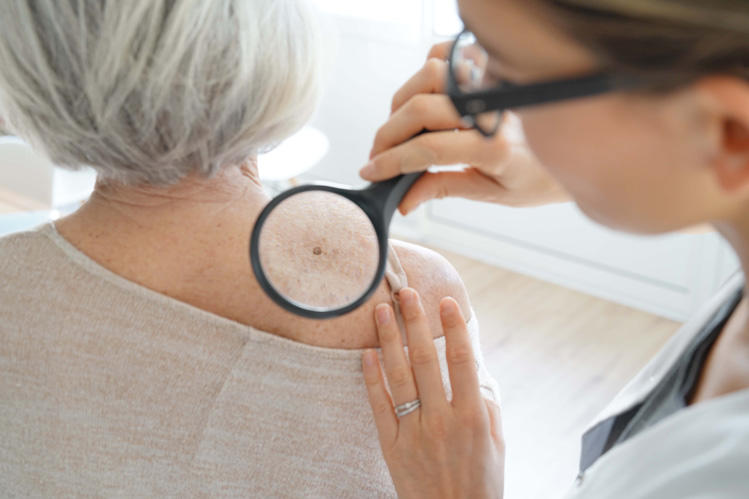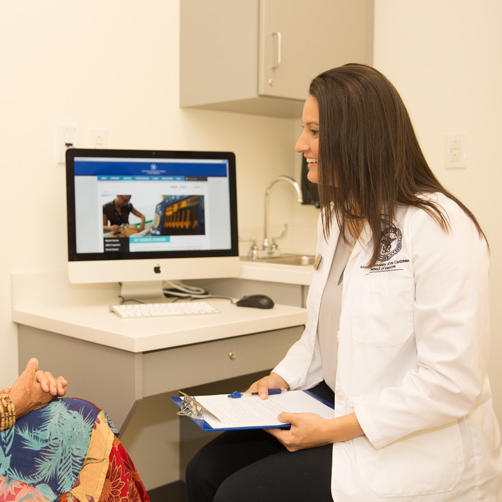A dermatologist is a doctor specially trained in finding, preventing, and treating diseases of the skin, hair, nails, and adjacent mucous membranes. Dermatologists are also colloquially referred to as “skin doctors.” If you are fascinated by the human body’s largest organ (the skin), and you want to care for patients with such skin disorders as acne, psoriasis, or eczema, then you may want to consider a career as a dermatologist.
What Do Dermatologists Do?
As a dermatologist, you will be able to identify and treat more than 3,000 conditions, and you can help improve the quality of life for people suffering from minor and irritating conditions to severe and life-threatening maladies. The most common skin conditions treated by dermatologists include:
- Acne
- Alopecia areata (loss of hair in small patches)
- Atopic dermatitis (eczema)
- Blocked skin follicles
- Bacteria and dead skin buildup
- Psoriasis
- Rosacea
- Skin cancer
- Vitiligo (the loss of skin pigment)
Dermatologists must also be able to diagnose and treat such rare skin diseases as:
- Actinic prurigo, or AP (itchy rash from sun exposure)
- Argyria (change in skin color because of silver buildup in the body)
- Chromhidrosis (colored sweat)
- Epidermolysis bullosa (a connective tissue disorder that causes fragile skin)
- Harlequin ichthyosis (thick, hard patches or plates on the skin)
- Lamellar ichthyosis (red, scaly outer layer of skin)
- Necrobiosis lipoidica (rash and sores on the lower legs)
Many dermatological conditions are not life-threatening, but they can drastically diminish a person’s happiness and overall well-being. Such conditions as acne and psoriasis in particular can produce anxiety, depression, and other psychological problems. In treating skin conditions, dermatologists can dramatically improve their patients’ quality of life.
Dermatologists are also bona fide lifesavers. They are the front line of defense against the most common type of cancer—skin cancer. About 100,000 people in the United States are diagnosed with melanoma each year, and about one person in 12 will die from it.
Lifestyle factors and underlying health conditions may negatively affect the skin. Other skin problems may be caused by:
- Bacteria in the pores or hair follicles
- Conditions affecting the immune system, kidneys, or thyroid gland
- Contact with allergens, contagious diseases, and other environmental triggers
- Diabetes
- Fungus or parasites
- Genetics
- Medications
- Sun exposure
- Viruses
How to Become a Dermatologist
To be a dermatologist, you must first become a physician by graduating from an accredited medical school—such as American University of the Caribbean School of Medicine (AUC). After earning a Doctor of Medicine (MD) degree, graduates must then do a residency, which is required to become a licensed physician. Future dermatologists must do a preliminary transitional year in a broad-based clinical specialty (usually internal medicine) before completing a three-year residency in dermatology.
After the successful completion of dermatological training, a doctor may be certified by the American Board of Dermatology, the American Osteopathic College of Dermatology, or the Royal College of Physicians and Surgeons of Canada. A board-certified dermatologist may earn the abbreviation FAAD, meaning the doctor is a Fellow of the American Academy of Dermatology. Doctors may then take additional training to subspecialize in one of the four main branches of dermatology seen below.
Subspecialties Within Dermatology
Dermatology is a highly specialized field. But some dermatologists choose to specialize even further, pursuing one of many subspecialties.
- Cosmetic dermatology involves the treatment of problems that affect appearance. A cosmetic dermatologist may treat such common skin problems as acne and moles. Cosmetic dermatologists may also treat the effects of aging, improving the appearance of wrinkles and sunspots.
- Dermatopathology combines dermatology with pathology, the study of disease. Dermatopathologists specialize in diagnosing skin disease by analyzing samples under a microscope. Many dermatopathologists are involved in the diagnosis of skin cancer.
- Mohs surgery is a special technique used to treat certain types of skin cancer. A Mohs surgeon removes a small amount of tissue from a lesion at a time, analyzing it under a microscope for cancer cells. This painstaking process enables the surgeon to get all of the cancer while removing a minimum of healthy tissue.
- Pediatric dermatology involves treating the skin of children. Pediatric dermatologists treat many of the same skin disorders that affect adults, but in kids. They may also treat concerns particular to children, such as birthmarks.
What Does a Dermatologist Do? (Work Environment)
Dermatologists are in high demand, so a typical workday may involve a busy schedule. However, more than many other specialists, dermatologists tend to see people on a scheduled, non-emergency basis. As a result, they often enjoy more regular work schedules than many other doctors.
Some dermatologists are in solo practice, maintaining their own office, but most work in a group practice with other dermatologists. A small number work in hospitals or in academic settings, training the next generation of dermatologists.
Many common dermatological problems require ongoing treatment. As such, dermatologists, particularly those in private or group practice, may have long-term associations with patients.
Issues that affect the skin are among the most visible medical conditions. A result, they unfortunately tend to carry an outsized social stigma and impact on self-esteem. Navigating patients through the emotional as well as physical dimensions of their treatment is part of the challenge—and reward—of dermatology.
Meet a Dermatologist
Lauren Boshnick, MD, a 2018 AUC graduate, is a board-certified dermatologist at Dermatology Specialists of Illinois near Chicago. We asked Dr. Boshnick about being a dermatologist.
Q: Why did you decide to go into your specialty?
A: I always knew I wanted to be a physician. During medical school, I was immediately drawn most to subjects that involved great detail like immunology, microbiology, molecular cell biology, and pharmacology. I enjoyed understanding the small parts and fitting them into the large picture. Dermatology is a field of great complexity and detail and I found myself immediately drawn to it. I enjoy the mixture of cases that dermatology offers. I also enjoy the different ways I can help people in dermatology with surgery, laser therapy, cosmetics, or medical therapy. It is immensely rewarding to be able to apply my medical knowledge to the patient at the bedside and see them get better.
Q: What’s the most rewarding part of your job?
A: The most rewarding part of my job is visibly seeing my patients get better. In dermatology, each case has a unique approach to helping the patient get better. I also enjoy seeing patients of all different backgrounds and ages and building long-standing relationships with them.
Q: Any advice to medical students considering the specialty?
A: I would advise anyone interested in dermatology to work to master their subjects in medical school. Dermatology is incredibly competitive and requires true devotion to the field. A competitive application likely requires a high grade point average and high United States Medical Licensing Examination® (USMLE®) scores in addition to a competitive resume of publications and academic endeavors. Whatever your passion may be, work hard to pursue it! It has been incredibly rewarding to achieve my goal and I am forever thankful for the opportunity AUC provided me.
Job Outlook for Dermatologists
The need for dermatologists is driven in part by the growth of the overall population. Also, skin cancer diagnoses are on the rise, increasing the demand for treatment. The aging of the population is leading to an increase in demand for cosmetic, skin cancer, and other services. In warm and sunny areas, the demand for the treatment of skin cancer and other sun-related issues is particularly high.
If a career as a dermatologist appeals to you, check out the MD program at AUC, review the admission requirements, and—if you’re ready—apply for admission to AUC today!
Related resources:





